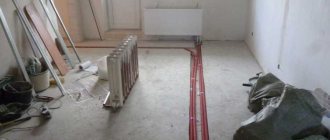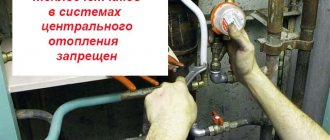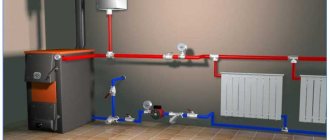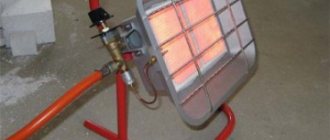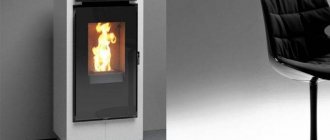Gas boiler for heating system
The most common is the autonomous heating scheme, in which the central element is a modern double-circuit gas boiler. It is a fairly compact device that is mounted on the wall. This device has a special chamber in which the fuel combustion process occurs. Moreover, the advantage of this type of boiler is that there is no need to create a special flue. A modern individual heating system in an apartment allows the boiler to use air, which is supplied directly from the street through a small pipe. The boiler is equipped with a specially designed chimney, which allows you to carefully remove smoke without causing inconvenience to apartment residents or their neighbors.
Gas boiler in the apartment
It should be noted that the individual system circuit itself is equipped with a fairly large number of different sensors that monitor its operation at various levels.
The use of such sophisticated technology ensures the fastest and highest quality, and most importantly, safe operation of the system. For example, gas will not enter the combustion chamber until the system receives feedback about normal operation from all sensors present in it. After this, the circulation pump starts working - it is responsible for the continuous movement of the coolant. In parallel with this, a vacuum is created in the chamber using a special fan. And only after that a small spark is supplied, from which the gas flares up. Moreover, the entire verification process takes only a fraction of a second.
Safety of gas boilers in apartments
Nowadays, manufacturers offer many boiler options. If you follow the operating rules, then they are all safe. But every boiler that uses autonomous gas heating in an apartment is serious equipment that requires adjustment and constant monitoring of its operation.
Minimum requirements for installing a gas boiler
If your apartment does have a chimney, then after some time soot will accumulate there. It must be cleaned at least once a year. If this is not done, the efficiency of the boiler will significantly decrease and the release of substances will increase. For example, if a new boiler emits one of these substances, then one that has worked for several years without cleaning will already emit two.
Individual heating in the apartment
Today, each boiler is equipped with automatic combustion and safety automatics. The latter is designed to turn off the gas supply if the pressure is low, and after the pressure is restored, the boiler should not start on its own without purging.
It often happens that after several attempts an error is displayed. And if the boiler is relatively old, then such a system may not exist. Such a boiler will require ventilation and manual start. If the automation does not work, gas contamination of the boiler and room may occur. There are many organizations involved in the installation and maintenance of boilers, so you should not try to fix it yourself, even if you think you can see what is wrong or wrong.
Requirements for chimney installation
When installing a gas boiler of any type in an apartment in an apartment building, the chimney cannot be made narrower than its outlet pipe. If the device has an open combustion chamber and a power of no more than 30 kW, the cross-section of the chimney pipe cannot be less than 140 millimeters, and with a productivity of 40 kW - 160 millimeters in diameter.
If the boiler has a closed combustion chamber, it is equipped with a coaxial chimney with a cross-sectional size recommended by the manufacturer.
Next you need to adhere to the following rules:
- the pipe going upward from the wall-mounted gas unit must have a length of at least 50 centimeters, and only then can the elbow be installed;
- more than three bends cannot be created along the entire length of the chimneys;
- combustion products from appliances with open combustion chambers are removed into the chimney, and with closed ones, also into the chimney or through the wall directly to the street (the method depends on the project).
Electrical systems
There are not only many varieties of electric boilers, but also many options that allow you to construct a project. For example, an apartment owner has several options for heating a room:
- warm floor;
- electric boiler;
- Heat pump.
The first two methods are not always advisable to install, since they are expensive to install, and you will also have to pay a lot for electricity. Electricity, like other energy resources, is constantly becoming more expensive. If you install an electric boiler, you must remove all the old equipment and install new ones, just as in the case of a gas installation.
Warm floors are more efficient than a boiler due to its features. If all heating elements are located evenly across the entire floor, and the air is heated from the bottom up, then much less energy will be needed to create comfortable conditions.
But it is better to do autonomous heating of an apartment in an apartment building in the form of a heat pump. Two types of such devices can be used: air-to-air and air-to-water.
People are often interested in the question of whether it is possible to install autonomous heating in an apartment at a low price. In this case, they should not look closely at thermal devices. The cost of heat pump equipment can be high. In addition, the price per unit of energy spent will also be slightly higher when compared with gas equipment.
But on the other hand, if we talk about the long term, then such equipment is interesting to install. Also, a device that operates on the air-to-air principle can perform the functions of an air conditioner in the summer, since their operating principle is the same. In this regard, a heat pump is sometimes called an air conditioner.
Before installing an air type device, you must choose the right model. It is better to install multi-channel equipment in apartments with a large area. Buying such a device for a small apartment is not advisable, since its cost will be significant and the electricity bill will not please you.
For small apartments, it is beneficial to install separate split panels for each room separately. In this case, there will be no need to install air ducts. This option is ideal if the renovation of the apartment has already been completed, since installation does not require breaking down the walls. In addition, one system can produce up to 5 kW of heat. In the northern regions, a combined heating system is used: in winter they use a gas boiler, and in summer - an electric one. Thus, it is possible to save a lot of resources.
Overview of installation of water heated floors in an apartment:
Obtaining permission for individual heating in an apartment [year]
The procedure for arranging autonomous heating is regulated by the norms of the Housing Code (Articles 26 and 27) and Federal Law No. 190 of July 27, 2010 “On Heat Supply”. In accordance with these documents, in order to install an autonomous heating system in your apartment, you must obtain the consent of local government authorities.
It is issued by an interdepartmental commission responsible for the use of housing stock. A complete package of documents must be submitted to this authority. Authorized employees will study the request, assess the risks of disconnecting a specific apartment from the heating network and make a decision. Officials are given one and a half months to do all this. The final document drawn up by the commission is issued to the applicant within three days after the decision is made.
Preparing documents also takes a lot of time. Its features depend on what type of heating the applicant has chosen - electric or gas.
In the first case, it is enough to write a statement about disconnection from the central heating supply to the city heating networks, coordinate your actions with the administration and submit an application for the installation of an autonomous heating system.
To install a gas boiler, residents must:
- Apply to the gas service.
- Obtain from the fire inspection a document confirming the proper operation of the chimney and ventilation.
- Obtain written consent from neighbors to install autonomous heating.
- Obtain permission from heating networks to draw up and approve a plan for an autonomous heating system.
Now you can begin dismantling the old equipment and installing the new one. The right to connect an individual heat source is granted only to specialists of gas supply organizations. Self-installation poses a threat to life, and neighbors or regulatory authorities may sue. In total, obtaining permits and installation takes from three to six months.
Requirements for chimney installation
When installing a gas boiler of any type in an apartment in an apartment building, the chimney cannot be made narrower than its outlet pipe. If the device has an open combustion chamber and a power of no more than 30 kW, the cross-section of the chimney pipe cannot be less than 140 millimeters, and with a productivity of 40 kW - 160 millimeters in diameter.
If the boiler has a closed combustion chamber, it is equipped with a coaxial chimney with a cross-sectional size recommended by the manufacturer.
Next you need to adhere to the following rules:
- the pipe going upward from the wall-mounted gas unit must have a length of at least 50 centimeters, and only then can the elbow be installed;
- more than three bends cannot be created along the entire length of the chimneys;
- combustion products from appliances with open combustion chambers are removed into the chimney, and with closed ones, also into the chimney or through the wall directly to the street (the method depends on the project).
Heat supply of an apartment building
The following heat supply methods exist:
- Installation of heat pipelines from central heating networks.
- Installation of an autonomous heating point.
Diagram of a double-circuit heating system.
These heat supply methods are equally effective, but having an individual heat supply point with autonomous heating for several apartment buildings is much more convenient. Since the distance between the heat supply point and the consumer itself is significantly reduced, which means heat losses along the heat transfer line are reduced. This heating method is called decentralized or autonomous.
Autonomous heating and its advantages:
- With autonomous heating of a room, the heat supply source is located at a minimum distance from the house, which reduces the time of heat supply and the percentage of heat losses, which results in further reductions associated with maintenance costs, maintenance and repair of heating networks.
- Since the heat supply point is located nearby, utility costs are noticeably reduced.
- Complete independence from the general city schedule. This means that it is always possible to connect apartment heating if necessary.
- Each apartment owner can set the optimal temperature in the heating system only for his home, while he has the opportunity to independently regulate the level of heat supply.
- There is an excellent opportunity to install a heated floor system.
- The presence of an autonomous heat supply point affects the lower cost of an apartment in a new building.
Autonomous heating and its disadvantages:
House heating scheme using a gas double-circuit boiler.
The best option for autonomous apartment heating is heating powered from a central gas pipeline or through the power supply network, which completely depends on the type of boiler. In apartments, it is most practical to use wall-mounted boilers for heating the home, which, in turn, are divided into gas and electric.
Until recently, there were practically no alternatives to centralized heating in our country. Accordingly, the service was paid at a single rate, despite the degree of use of the service. Today the market is replete with autonomous heating systems of different types and from different manufacturers.
Individual heating
Many homeowners who have financial resources install individual gas heating in their apartments in order to independently control the level of consumption and save on the “heating and hot water supply” column in regularly received receipts, which is growing every year.
The initiative was taken up, and now individual gas heating, even requiring expensive equipment and significant installation costs, is used more and more often. The benefit is obvious: sometimes the money spent can pay off fairly quickly, even within one heating season.
Autonomous heating of the house
Consumers have come to the conclusion that autonomous gas heating at home is very useful and profitable. The autonomous system is closed. Therefore, gas equipment for heating a house is a set consisting of an expansion tank, designed to compensate for the thermal expansion of the coolant, and a circulation pump, which ensures the movement of the working fluid along the heating circuit. Sometimes there is no need for a pump (if the heating system operates on the principle of natural coolant circulation). But today this is rarely practiced.
The advantage of such a gas heating system for a private house is that antifreeze (non-freezing liquid) can be used as a coolant, which makes it possible to do without draining it from the system in case of suspension of work in the winter.
Owners of country houses most often choose individual autonomous systems for heating their premises. In most regions of the Russian Federation, the heating season lasts about nine months, so you need to think about how to heat your house in advance. Every heating system is not perfect - it has its pros and cons. When making a choice, you need to take into account all the nuances: room layout, prices for equipment and installation, etc.
If your house is connected to a gas main, then this immediately tips the balance in favor of gas heating. Individual gas heating will be the best option in this case.
Why services don’t like autonomous heating for residents
As a rule, all heat supply organizations are opponents of autonomous heating in apartment buildings, especially if from the very beginning the house was designed specifically for centralized heating. If one of the residents installs an autonomous boiler, this will unbalance the internal heating system of the entire residential building.
In addition, sometimes separating and installing your own gas heating in an apartment in post-Soviet countries is accompanied by violations of safety requirements and documentation.
As a result, it turns out that the one who separated remains in economic benefit, and the remaining residents only suffer from this.
One of the disadvantages is the violation of hydraulic balance. So, it turns out that in some apartments the rooms are very hot, while in others, on the contrary, they are cold. Therefore, heat engineers have to intervene and adjust the heating system.
In addition, there is also an environmental aspect. It is very good if individual gas heating in the apartment was installed in a building that has an old structure - that is, the presence of a chimney is provided. But in modern multi-storey buildings there is no such kind of ventilation: ventilation ducts are only in the kitchen and bathroom.
Autonomous heating in the apartment
Typically, residents install chimneyless gas boilers that have a coaxial pipe through the wall under the window. Gas combustion products are usually discharged through the pipe. And this leads to the fact that gas combustion products (carbon, carbon monoxide, a combination of sulfur, oxides) enter the apartment owner or his neighbors through the open window. Even though many modern boilers are equipped with a closed combustion chamber, this fact cannot be ignored.
Parapet boiler chimney
Selection of radiators
The most suitable option for autonomous heating is sectional batteries. The length of the radiator is influenced by the quality of heat transfer of one section, which, in turn, depends on the material of manufacture. One cast iron section, for example, produces 110 watts of heat, steel - 85 watts, aluminum - from 175 to 199 watts, the heat output of one section of bimetallic radiators is 199 watts.
To calculate the area heated by one section with a ceiling height of 2.7 m, you need to divide the heat transfer rate of the section by 100. For example, a section of a cast iron battery heats 1.1 m². Depending on the size of the room, you can calculate the number of sections for the radiator.
Nuances that may be present when calculating the number of sections in a room:
- in a corner room or one with access to a balcony, 2-3 sections are added;
- the decorative panel covering the battery reduces heat transfer by 15%;
- the niche under the window sill in which the radiator is installed reduces heat transfer by 10%;
- windows made of multi-chamber profile, on the contrary, make the room warmer;
- insulated walls and floors maintain room temperature well.
Apartment heating: how it works
Apartment heating is a mini-boiler room in each apartment. Residents have full control over the temperature of the house, can change it, turn the heating on and off at any time.
For apartment heating you need:
- boiler;
- meters that record fuel consumption; heating elements;
- air capture equipment;
- pipes for removing smoke and gases.
The boiler must have clamps:
- flame presence control;
- monitoring of draft, temperature;
- a shut-off valve that operates when there is no fire.
A popular fuel for apartment heating is natural gas. For it, you can choose many options for heating boilers, while heat loss is minimal and output is maximum.
With apartment heating, the entrance, basement and attic are not heated. Due to freezing of these rooms in cold times, the lifespan of the house is reduced.
New buildings usually have apartment heating; in old buildings, if desired, you can also refuse central heating by laying pipes and installing a boiler.
Electric heating indirect heating
In this case we are talking about heat pumps of various types. Electricity will only be used to operate equipment that extracts heat from the environment. Therefore, its consumption is relatively small.
It must be noted that the use of heat pumps is optimal only in areas with a mild climate, where winter temperatures are quite mild and there is no frost.
The heat pump “takes” heat from the environment. The operating principle of such an air-to-air device is shown in the diagram
The best options for heating an apartment are air-to-air or air-to-water pumps. The former are similar in principle to air conditioners, so they can be used in summer to cool air masses indoors.
To obtain heat, you will need to purchase and install expensive equipment, but in the future the heat pump will pay off. A unit of heat obtained in this way costs approximately the same as that obtained using a gas boiler.
Heat supply of an apartment building
The following heat supply methods exist:
- Installation of heat pipelines from central heating networks.
- Installation of an autonomous heating point.
Diagram of a double-circuit heating system.
These heat supply methods are equally effective, but having an individual heat supply point with autonomous heating for several apartment buildings is much more convenient. Since the distance between the heat supply point and the consumer itself is significantly reduced, which means heat losses along the heat transfer line are reduced. This heating method is called decentralized or autonomous.
Autonomous heating and its advantages:
- With autonomous heating of a room, the heat supply source is located at a minimum distance from the house, which reduces the time of heat supply and the percentage of heat losses, which results in further reductions associated with maintenance costs, maintenance and repair of heating networks.
- Since the heat supply point is located nearby, utility costs are noticeably reduced.
- Complete independence from the general city schedule. This means that it is always possible to connect apartment heating if necessary.
- Each apartment owner can set the optimal temperature in the heating system only for his home, while he has the opportunity to independently regulate the level of heat supply.
- There is an excellent opportunity to install a heated floor system.
- The presence of an autonomous heat supply point affects the lower cost of an apartment in a new building.
Autonomous heating and its disadvantages:
House heating scheme using a gas double-circuit boiler.
- To build an autonomous boiler house, a specific place is required, and often the courtyard of a multi-story building is chosen for this.
- A gas autonomous boiler room requires an additional exhaust gas removal system.
- Since autonomous heating is not yet in such demand, the production of boiler equipment has not yet been established. This means that the cost of a decentralized heating system and domestic hot water remains high.
The best option for autonomous apartment heating is heating powered from a central gas pipeline or through the power supply network, which completely depends on the type of boiler. In apartments, it is most practical to use wall-mounted boilers for heating the home, which, in turn, are divided into gas and electric.
Pros and cons of autonomous heating in an apartment building
Before you decide to make such drastic and expensive changes, it is worth studying the advantages and disadvantages of a custom heating system. The advantages include:
- Saving money. To maintain a comfortable climate in an apartment, much less energy is required than with centralized heating. Some owners of individual systems claim that heating costs are reduced by about seven times. And this is understandable, because they no longer have to pay for losses in the heating main.
- Independence from utilities and the established period of the heating season. If necessary, the living space can be heated in the off-season, when there are strong temperature changes outside.
- People have the opportunity to set the temperature in their rooms at their own discretion. Modern equipment allows you to adjust the settings so that, for example, one temperature is maintained at night, and another during the day, when no one is home. In addition, some systems are capable of responding to changing weather conditions.
- Residents have the right to install a double-circuit boiler and independently provide themselves with hot water. This will help get rid of the problems associated with summer shutdowns of hot water supply.
- Since there is no possibility of water hammer in the pipeline, you can choose batteries of any type.
The main disadvantage is that you will have to spend money on such equipment. The cost of installing individual heating in an apartment ranges from 50,000 to 200,000 rubles. In addition, residents will have to worry about coordinating the procedure, installing the system, and arranging a suitable exhaust duct
Owners must take full responsibility for the safe operation of the equipment. But, despite this, specialized organizations have the right to control the installation process; their representatives will have to be allowed to inspect.
Brief instructions for installing a geyser
This information should not be considered as a guide to action. Replacing a water dispenser with your own hands, as well as working with any gas appliances, is prohibited not only by law, but also by common sense: such “amateur activity” in an apartment building can lead to disastrous consequences.
For work use:
- certified geyser;
- PVC water pipe;
- American type fittings;
- pipe cutters;
- soldering iron;
- metal-plastic pipe for gas supply;
- fittings for metal-plastic;
- gas taps;
- salt and magnetic filter;
- Mayevsky crane;
- regular water tap;
- proportional wrenches;
- drill;
- as well as dowels and screws.
Progress of work and basic requirements for them:
The choice of installation location for the dispenser should be based on the possibility of arranging the hood in accordance with all rules and regulations, the convenience of the dispenser location, as well as the possibility of supplying communications.
The volume of the room in which the column will be installed must be 8 m³ or more.
Speakers are installed only on fireproof walls. In another case, the fire-resistant surface is lined with a galvanized sheet from 0.8 to 1 mm thick, having previously secured a sheet of basalt heat-insulating cardboard from 3 to 5 mm thick to the wall.
IMPORTANT! Installing speakers on wooden walls is prohibited!
The column is hung on the wall, taking into account that the installation height can be arbitrary, but do not contradict the rules for installing the air vent. There should be at least 15 cm from the side panel of the speaker to the wall, and a space of at least 60 cm should be left in front of the front panel of the speaker.
At the installation location of the column, mark the fastening points, then drill them with a drill. The column is secured with self-tapping screws.
The standards for installing the connection between the column and the water supply system provide for the use of metal pipes or flexible hoses with an internal diameter of at least 13 mm. In this case, the length of the hose or pipe must be no more than 2.5 m (similar parameters must be observed when arranging a connection to the gas supply system).
Installation of a gas connection to a column must be carried out only with a shut-off valve installed.
Before installing the chimney, check the draft. Under normal conditions, it should be approximately 1.96-29.40 Pa (depending on the type of room).
The gas exhaust pipe must have at least 110 mm in diameter, while its length cannot exceed 2 m, but cannot be less than 300 mm. The slope of the gas exhaust pipe must be at least 2° upward.
IMPORTANT! It is also prohibited to independently carry out the first release of water through the column. All work related to testing the system, installing a new column or dismantling an old one must be carried out only by qualified representatives of GORGAZ. The speaker installation diagram must be included with the product.
The manufacturer's advice on installing this device is also given there.
The speaker installation diagram must be included with the product. The manufacturer's advice on installing this device is also given there.
Only kitchens and non-residential premises intended to accommodate these heating devices are suitable for installing speakers.
However, the installation rules prohibit installing a column in the bathroom, because... this room does not meet the basic requirements (see SNiP 2.04.08-87 GAS SUPPLY).
In previous regulations, the installation of speakers in bathrooms was allowed. But after the change in legislation, we can only talk about moving the speaker from the bathroom to the kitchen or any other non-residential premises, if it is necessary to replace the device with a new one.
Figure 4 — Gas water heater installation diagram
The requirements for installing speakers also make it possible to consider each individual case: for example, in a private house that does not belong to typical buildings, it may be possible to install a speaker in a wide corridor or a room without windows, but having access, however, to a spacious room with a window.
Figure 5 — Checking draft before installing a gas water heater
Features of individual apartment heating
When planning to switch to autonomous heating, you need to realistically assess your capabilities and understand that most of the options that are quite acceptable for private houses are impossible in a high-rise building. You should immediately “sweep away” solid fuel and liquid fuel boilers of all types.
This is due to the fact that their uninterrupted operation requires a supply of fuel, which is unsafe in an apartment building.
Individual heating in an apartment can be arranged in different ways. There are certainly fewer options than in a private house, but there are enough to choose the system that is most suitable for existing conditions
In addition, it is also extremely inconvenient. In this case, it is also prohibited to use a warm water floor. It is only possible to install one of its electrical varieties.
You need to know that when arranging individual heating in a high-rise building, you will have to take into account not only your own interests, but also the interests of other residents who may be dissatisfied with some of the difficulties arising as a result of your actions.
Therefore, choosing the right heat source is very important. This is an important stage that actually determines the success of the planned event.
Despite the limitations, there are still many options for autonomous systems. First of all, this is gas-fired heating. Moreover, you need to take into account that we are not talking about bottled fuel, but about connecting to the gas main.
The option with cylinders is not even worth considering, since it will cost much more than central heating, and is extremely inconvenient. Heating using mains gas is very economical and can operate completely autonomously.
The best source of heat for one of the apartments in a high-rise building will be a wall-mounted double-circuit boiler with a thermostat and electronic ignition. It will automatically maintain the most comfortable temperature and supply hot water.
If there is enough free space in the apartment, you should pay attention to a boiler with a boiler. This will stabilize the supply of hot water.
Electric heating can also be installed in apartment buildings. It can be implemented in several options, when electricity is used for direct heating, which is more expensive, or indirect.
A gas wall-mounted boiler paired with a boiler will, of course, take up quite a lot of space, but this will ensure an uninterrupted supply of hot water at the required temperature and in any volume
A system running on electricity can have a boiler or heat pump as a heat source, and an electric cable floor, infrared film, baseboard radiators or electric convectors as an energy transmitter.
The apartment owner can choose any suitable option or combine several. For example, heated floors and convectors. Let us consider in detail each of the possible methods of arranging autonomous heating.
If a gas water heater is not provided
In a house where the installation of gas equipment, such as a stove, is permitted, the installation of a water heater may be prohibited. This restriction applies to houses with more than 11 floors. No regulatory authority will issue permission to install a water heater in such an apartment, as this is dangerous for the residents.
In addition to the number of floors, redevelopment may be a reason for refusal. Studio apartments are not suitable for installing gas equipment, since the devices must be installed in non-residential premises.
If the kitchen is combined with a living room, this makes the use of gas appliances illegal. These limitations must be taken into account before redevelopment. The same can be applied to apartments where there is no kitchen or is shared.
Image gallery Photos from Gas water heaters with a flow-through principle of operation in apartments are mainly used to prepare hot water; in old two-story buildings they can serve as a unit for maintaining the temperature of the coolant. Installation of a gas water heater is allowed in houses no higher than five floors that are not connected to a centralized hot water system. In high-rise buildings connected to a central hot water supply system, gas equipment is not installed. Small private houses with an area of no more than 150 m² are also equipped with gas flow heaters. The instantaneous water heater processes the water passing through it in the amount necessary for immediate use. The gas water heater is not intended to form a supply of hot water. and maintaining its temperature, which explains its small, easy-to-use dimensions. Gas instantaneous water heaters for apartments are available in wall-mounted versions. They should be located so that free access is guaranteed for servicing the water heater and its connection points. Installation of more than two gas water heaters in one room is not allowed. The use of both flow and storage equipment is allowed in quantities of 1 piece each. An exception is multi-level apartments. Gas heating equipment is allowed to be installed only in private apartments and houses; placement in dormitories, gyms, hotels, etc. is prohibited. where different people can be used Flow-through gas water heater Productive small-sized device Operation of a water heater in private homes Advantages of a gas water heater Compact dimensions of flow-through equipment Features of heater placement Two gas water heaters in one room Installation of the heater only in residential buildings and apartments
If the house does not fall under these restrictions, then it is necessary to collect a package of documents to register the device.
The procedure is as follows:
- Write an application to the gas distribution company.
- Get a plan from the BTI or Rosreestr.
- Provide an extract from Rosreestr confirming ownership.
- Contact a specialized organization to draw up a project.
- Find certified specialists from an organization that has access to gas work.
After this, specialists will make an insert into the gas pipe, connect the device and put the water heater into operation.
It is highly not recommended to install a geyser yourself, bypassing the legal order. These actions not only lead to fines, but also put people's lives at risk.
Autonomous heating in an apartment: is it possible?
The desire to install autonomous heating is quite understandable. Calculations show that the cost of heating housing and supplying hot water should be significantly reduced. According to statistics, on average, they are reduced by two to three times for heating and four to five times for heating water.
The result is a significant amount. It is clear that you will have to spend money on installing equipment, on its maintenance and on purchasing energy resources, but the costs will be justified.
The utility industry is not at all interested in losing consumers of its services. Therefore, you need to be prepared for the fact that you will have to make efforts to implement your plans. First of all, you need to know exactly what the legislation says about autonomous heating in an apartment.
Very often, the apartment owner is denied disconnection from the central heating supply, citing Federal Law No. 190 “On Heat Supply”. However, this is unlawful, since there is Government Decree No. 307, which was issued on April 16, 2012. It prescribes the procedure for connecting autonomous heating systems in apartment buildings.
There is also a list of heat sources that are strictly prohibited for installing autonomous heating in such houses. Therefore, it is allowed to install individual heating provided that modern safe equipment is used.
You must understand that before purchasing and installing equipment, you need to obtain permission to disconnect from the centralized system and permission to switch to individual heating of the selected type.
To do this, you will have to collect a significant package of documents and wait for a decision to be made. Only after this can you begin to rebuild the heating.
Autonomous heating for an apartment in a high-rise building is profitable and practical. However, to be able to set up such a system, you will have to try. You should start by collecting a package of documents
Benefits of Autonomous Systems
An autonomous home heating system appeared for the first time in Europe. However, having a significant number of advantages, it quickly spread throughout the world. Today, in most countries, residents prefer to use individual systems for heating their apartments. And for good reason, since this method has several advantages over a centralized system:
affordable price. It is this advantage of the system that often becomes decisive when abandoning a centralized system. The fact is that even though you have to pay for the amount of gas used for heating, you will pay significantly less for utilities. In addition, unlike a centralized system, you can use autonomous heating when it is needed. That is, if necessary, you can adjust the heating intensity, and if you leave, you can simply turn it off completely for a while. This saves a lot of money. In addition, you will not experience the inconvenience that occurs when one of the heating elements of the riser of a centralized system breaks down - after all, in this case, several apartments are left without heating at once.
Heat supply diagram for a multi-storey building
- saving natural resources. With the gradual abandonment of centralized heating, users are thereby significantly helping to save a huge amount of resources that previously had to be spent on heating the house. In addition, with individual heating, it becomes possible to independently adjust the heating level. But even in this case, the heating boiler is often turned off by the user - that is, additional savings in natural gas occur.
- improving the quality of heating. In fact, those who have switched from a centralized heating system to autonomous heating in an apartment building have noticed a significant improvement in heating levels. Quite often this is due to the fact that heat is constantly leaking in a centralized system. In addition, autonomous heating of a residential building located in one apartment requires significantly less money and time for prevention.
Schematic diagram of heating of a high-rise building
Another advantage of autonomous heating is that the system also allows you to constantly heat water. That is, there is simply no need to use such resource-intensive boilers.
Heating system
Wall-mounted boiler for apartment heating system
For autonomy, the heating system in an apartment can be very different, but if we are talking about water circuits, then three main options can be considered here - “warm floor”, two-pipe and single-pipe heating systems. A combined option is also possible, which also brings very good results. But we will focus specifically on radiators, so dear and familiar to every post-Soviet person.
Two-pipe and one-pipe systems
Heating diagram in an apartment with two pipes
- The most reliable, perhaps, is a two-pipe apartment heating system, because with such wiring there is a minimum of heat loss. Here the coolant, in this case water, enters the radiator from the supply pipe, but returns from it to the return or “return” pipe. The pipes can be positioned in different ways - they can run two together, under the radiators, near the floor, or the supply can be mounted on top of the heating devices.
Single-pipe heating wiring diagram
- The situation is somewhat different with a single-pipe heating system, because in this case the water, flowing from the pipe into the radiator, again returns to the same pipe, but slightly cooled. It turns out that the further the heating device is from the beginning, the colder it will be, because the coolant, reaching it, cools down in other batteries. This design is good for two or three medium-sized batteries, in any case, you can allow up to five, but this would be too much.
Apartment heating diagram: number 1 indicates the bypass, and number 2 indicates the radiator
- Single-pipe apartment heating schemes can be with a bypass, as shown in the top picture, and can be without it, as can be seen in the bottom picture. The difference is that the jumper allows you to dismantle the radiator without stopping the circulation of the coolant - to do this, you just need to turn off the taps to the battery. But if there is no bypass, then by removing the heating device, you break the circuit, and therefore interrupt the circulation (the water supply to heated towel rails in apartment buildings is often assembled according to this scheme).
Single-pipe radiator connection without bypass
Advice. If the rooms in the apartment are located in the same line, then there is no point in installing a single-pipe heating circuit, because the pipe still needs to be turned back to the boiler. The material consumption will be the same, so it is better to use a two-pipe connection.
Installation of heating circuit
Complete heating scheme in the apartment
- Pipe made of plastic or propylene;
- Ball valves;
- Direct-flow radiator valve;
- Membrane expansion tank 18 l;
- Circulation pump included;
- Check Valve;
- Security Group;
- Heating radiators;
- Thermostatic valve;
- Angled or straight radiator taps (as required);
- Plug or foot;
- Mayevsky valves;
- Ball valve for draining water;
- Plug or foot;
- Thermostatic heads.
Tips: the diameter of the pipes is indicated in the diagram, but using polypropylene (eco-plastic), the supply and return can be done with the thirty-second pipe (outer d-32 mm), and the outlets to the radiators can be made with the twentieth. It is also better to use faucets made of polypropylene, because they practically do not boil and their service life is longer than that of metal ones.
Radiators for autonomous heating
Aluminum radiator ELEGANT
- Until recently, as required by the instructions, you probably had cast iron radiators that were connected to a centralized heating system. But for autonomy, such heating devices are not profitable, for at least two reasons - firstly, they have too large a capacity and a lot of water needs to be heated and, secondly, cast iron is not a very good heat conductor (too thick) and therefore takes a long time to warm up. As a result, you will end up with excessive gas consumption and unreasonable expenses of money.
- The most suitable heating radiators for apartments are made of aluminum, steel and bimetal. Any of them are suitable for low pressure, such as a small water circuit, and all of them can withstand high temperatures. If you wish, you can also combine radiators and a water heated floor system in one circuit.
Advice. The most effective (the price is also the highest), but also the most capricious of all the above heating devices are aluminum radiators, and if there is a high content of alkalis in the water, neutralizers must be added to the system. Also, the presence of copper in the circuit should not be allowed, since the interaction of these two non-ferrous metals leads to their oxidation and destruction.
Radiator calculations
The number of sections can be reduced or increased
- To calculate the number of sections in a radiator required for a room with ceilings no higher than 3 meters, you can use the formula S*100/P. Here S denotes the area of the room, and P is the rated power of the section, which usually ranges from 180 to 200 W. The number 100 displays the required amount of W/m2, and the letter K denotes the initial result.
- Take, for example, a standard room of 3.5 × 6.5 m = 22.75 m2, batteries with a power of one section of 185 W and substitute the values into the formula. We get K=S*100/P=22.75*100/185=12.29, but there cannot be a fractional number of sections, so we round the number up (as a reserve) and get a heating device consisting of 13 sections.
Panel radiators of different sizes and power
- But what if you purchased panel heating radiators for your apartment, because they are not disassembled into sections, but simply vary in power and size. In this situation, a formula is also used, but, of course, a different one - P=V*41. The letter P here will correspond to the initial power, V – the volume of the room, 41 – the number of W/m3. For calculations we use a small bedroom with a height of 250 cm and an area of 225 * 450 = 10.125 m2, which means V = 2.5 * 10.125 = 25.3125 m3.
- Now we calculate the power of the radiator, which we will have to install with our own hands in this very bedroom. This means P=V*41=25.3125*41=1037.81.25W. Of course, there are no heating devices with such power, therefore, depending on the climate of your region, we choose either a 1 kW or 1.5 kW battery.
Welding polypropylene
Heating polypropylene with a soldering iron
- The most effective heating of apartments is obtained from polypropylene heating pipes, and this implies not only the heat transfer of radiators, but also the price of the circuit and the speed of its installation. For wiring, as mentioned above, a pipe reinforced with aluminum foil with a diameter of 32 mm and 20 mm is used.
The pipe connects to the tee
- Polypropylene is heated at a temperature of 280⁰C-300⁰C, holding the pipe and fitting on the hot nozzle for 5-6 seconds. Then the parts are removed and connected to each other by inserting into each other, as in the photo above. After fixation, they are held for another 5-6 seconds.
How to make a calculation
A comfortable temperature in the apartment will be maintained if the heating system is installed correctly. To do this, it is necessary to accurately make all calculations, which will depend on the area of the room (S) and the boiler power (W) per 10 m². It is also necessary to take into account the climatic features of the region. For example, for the Moscow region the power density ranges from one to one and a half kW; in the northern regions - from one and a half to two kW; in the southern regions - from 0.7 to one kW.
Heating calculations also depend on the design and type of heating system. The best option for an apartment is a two-pipe system. It is more complex and more expensive than a single-pipe system, but the heating quality will be higher. All batteries, from the first to the last, will heat up evenly. The single-pipe system is only suitable for a small number of radiators.
Installation of an autonomous heating system in an apartment step by step
Coordination of all planned alterations with the relevant organizations. Notifying neighbors that work is planned at a certain time. The time frame will need to be agreed upon in advance, since such repair work is always accompanied by loud noise. You don't want conflicts with your neighbors. If gas heating is planned, then a special chimney must be equipped in advance. If the device is electric, you will have to install a separate line of appropriate power in advance to power it. Where the heating device is installed, the floor finishing must be made of non-combustible material. According to the standards, a certain distance from walls and furnishings is provided. The next step will be to mark the boiler, pipes and radiators according to the prepared project. If the system operates with a gas boiler, you will need to install a gas flow meter. This is not required for electrical equipment. Buy and deliver the boiler to the installation site. While still in the store, check it for completeness, as well as for the absence of visible defects and damage. Even minor scratches on the body may indicate that the boiler was either transported incorrectly or was dropped by movers. And all this can lead to breakdowns that are not noticeable upon purchase and can only be discovered during operation. Installation of gas equipment
Particular attention should be paid to leveling the boiler horizontally and vertically; Only correct installation guarantees stable operation of such a heating device. Laying heating pipes according to the project diagram. As a rule, circuits with forced coolant circulation are used
Therefore, if a pump is not provided inside the gas boiler, then it will need to be purchased and installed. Boiler piping - connecting equipment to water supply and gas supply pipes. And also an exit to the chimney. Connecting heating radiators. If necessary, purchase and installation of new heating elements. Test launch of an autonomous heating system. It is necessary in order to find and eliminate possible leaks in joints, and check the performance of gas or electrical equipment, as well as the efficiency of the entire system.
An autonomous heating system is profitable and efficient. However, we should not forget that autonomous heating in an apartment with your own hands is an unsafe undertaking. Moreover, if you plan to use gas equipment, then only specialists should install it.
In general, we answered the question of whether it is possible to install autonomous heating in an apartment: not only is it possible, but it is often necessary. After all, utility bills are only growing every year, and heating bills are the highest.
Gas heating in the apartment
Such a system represents a closed circuit with coolant circulating inside.
A gas-fired boiler is used to heat the liquid. It can be single or double circuit. It all depends on the needs of the people living in the apartment. As you know, gas boilers can be floor-mounted or wall-mounted. For apartments, the second option is chosen. These are compact, but at the same time quite powerful devices. For an apartment, you should choose a heating device with a closed burner. Such devices do not take air from the room and do not require a traditional smoke exhaust system.
The latter is not always possible in an apartment building. Boilers with turbocharging require a special type of chimney, which is quite easy to install.
What benefits does the owner of gas heating receive? First of all, it ceases to depend on the timing of the heating season. The boiler is ready for use at any time and can be started as needed.
The cost of fuel is relatively low. Compared to heating with electricity, for example, operating a boiler will cost much less. In addition, if you install thermostatic valves on the batteries and purchase a heating unit with automatic control, you will be able to save on its operation.
In new buildings with individual heating of apartments, the problem of removing smoke from a gas boiler can be solved in this way: the picture shows the pipes through which street air is supplied to the burner. The smoke is discharged into the central smoke exhaust shaft
This is explained by the fact that the automation will regulate the temperature in the rooms, selecting the most economical operating mode and turning off the equipment when the set temperature is reached. It will not be possible to do this “manually” even if you want to.
The advantages include the compactness of gas heating equipment, its high efficiency and quite affordable cost. The solution also has disadvantages. The most obvious are related to the potential dangers posed by gas heating.
The owner of the apartment will be required to obtain a package of permits for the installation of gas equipment. However, you need to understand that it will be received only if the apartment fully complies with safety requirements. The purchased equipment must be certified.
Installation, connection and subsequent maintenance should only be carried out by specialists. In general, gas equipment should be handled extremely carefully and no amateur activity, be it a self-made part for the boiler or self-repair of the device, is unacceptable here.
Gas equipment is considered potentially dangerous. It must be handled with extreme care. Its maintenance, installation and repair should only be carried out by certified specialists
Disadvantages include the energy dependence of the system, which will not work without electricity. Despite the shortcomings, practice shows that gas heating is becoming the most common choice among apartment owners.
It allows you to get maximum cost savings and at the same time get efficient heating of your home. The possibility of parallel arrangement of hot water supply makes this solution even more attractive.
What to choose: single-pipe or two-pipe heating system
Two-pipe heating system
There are only two types of heating systems: single-pipe and double-pipe. In private homes, they try to install the most efficient heating system
It is very important not to go cheap when trying to reduce the cost of purchasing and installing a heating system. Providing heat to your home is a lot of work, and so as not to have to install the system again, it is better to understand it thoroughly and make “reasonable” savings.
And in order to draw a conclusion about which system is better, it is necessary to understand the operating principle of each of them. Having studied the advantages and disadvantages of both systems, both from the technical and material side, it becomes clear how to make the optimal choice.


